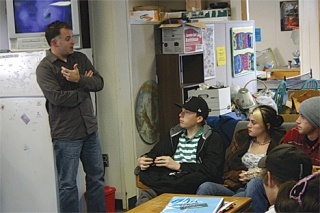In Leandra Reuble’s English classroom, a trifold poster board is scrawled with messages and photos warning against the use of crystal meth. One Midway High School student wrote, “Not as glamorous as it looks!” next to a photo of an emaciated man.
Although the board was created several years ago, the next generation of students protested its removal.
“There isn’t a drug problem at Midway,” Reuble said. “Most who have experienced it have been through rehab and are past it. But they want to get the message to other kids, who don’t think it will touch them.”
Last Tuesday, the dangers became more personal when Jamie Crawford, 23, of Yakima, shared her story of methamphetamine addiction with students at Oak Harbor’s Midway High School. She was there as part of a campaign by Attorney General Rob McKenna: “Operation: Allied Against Meth.”
McKenna was called away to Washington, D.C. for the financial crisis and could not attend.
Anti-drug activist Travis Talbot and Crawford spent 45 minutes with students, providing facts and showing them video clips.
The average life span of a habitual meth user is five years, Talbot told students. Washington has one of the most serious meth epidemics in the country, due in part to cross-border trafficking. It has the largest number of federal drug seizures of meth in the Pacific region.
“Meth reminds me of a controlling relationship. You don’t see what they are at the very beginning,” Talbot said.
Part of Talbot’s work as the executive director of the nonprofit Lead On Americawas to visit neighborhoods and help them remove meth houses. He told the teens about the paranoia he witnessed and that 90 percent of people become addicted to meth the first time they try it.
To put the statistics in perspective, Crawford stepped up and described the drug culture and lifestyle she once lived. She said she first tried meth as a teen, later dropping out of school and spending time in prison.
At age 16, she saw a man get his finger chopped off over a pack of cigarettes. By 17, she knew five people who were murdered, and she knew who committed the crimes.
“We were so selfish. We didn’t care,” she said.
Eventually, Crawford got clean after facing a long sentence in prison, and earned her GED. She is studying to become a nurse.
Crawford has visited over 50 schools since 2005, giving her speech at big assemblies. Friday was her first time speaking to a classroom of 30. The teens’ expressions were somber throughout the speech, and they questioned her about what life is like for her now.
She said her brain can’t function as it did before the meth use and she often forgets things. And because meth damages the dopamine neuron, she doesn’t feel the same level of joy.
Talbot asked the students if they knew a place to find meth in the community. After a long silence, one student said, “It’s Oak Harbor, you can find it anywhere.”
The prevalence, Talbot said, is because meth is easy and cheap to produce. Although there were only 200 meth houses reported last year (a drastic decline), drug cartels from Canada and Mexico smuggle it over the border.
Crawford said positive reinforcement from the family structure could help. Her family supported her during her court trials.
“I quit meth because there are bigger and better things for me out there. You only live once,” Crawford said.
Her story resonated with some of the students, such as junior Jamie Marriott, who knows firsthand how the drug can affect someone she cares about.
“I know someone who does meth and I’ve seen what’s happened. It’s terrible that they suffer. They’ll do anything for it,” Marriot said. “It’s good that (the speakers) let us know what the drug could do to you and the experience of it, before people try it for themselves.”
Students were encouraged to attend the 2008 Washington State Prevention Summit in Yakima, Oct. 17 and 18.



